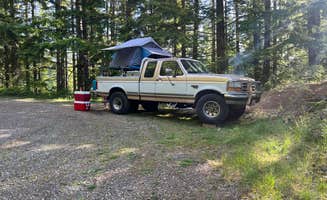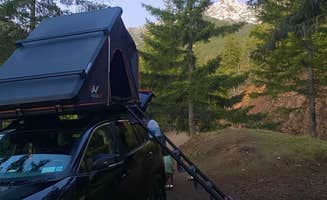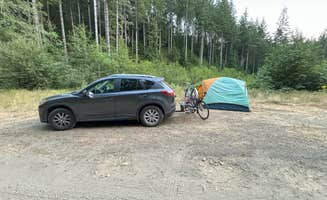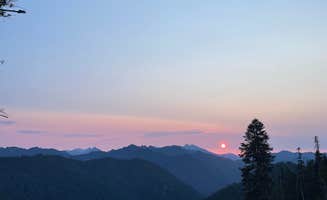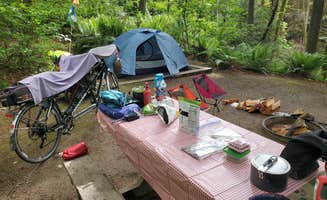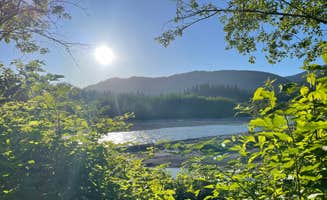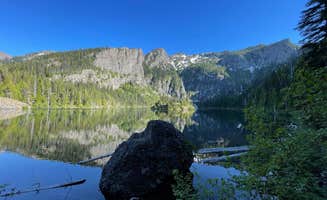Primitive camping near Hoodsport, Washington offers numerous dispersed sites throughout Olympic National Forest at elevations ranging from 800 to 3,000 feet. Forest Service roads in this area typically open between April and November, with many higher elevation routes closed during winter snowfall. Access conditions vary significantly based on recent weather and maintenance schedules.
What to do
Hiking from camp: Multiple trails accessible from NF-2419 dispersed areas, including routes to nearby creeks. "There are various streams crossing the path of the service road. Truly magical place," notes one camper at NF-2419.
Wildlife viewing: Forest roads near Hoodsport provide opportunities for bird watching and small mammal sightings. A visitor to NF-2419 reported, "Got to feed 3 Bluejays by hand with my oldest one of our new favorite memories."
Stargazing: Minimal light pollution at higher elevation sites creates excellent night sky viewing conditions. An Hilltop Camp visitor described "no light pollution or car sounds at night" during their December stay.
What campers like
Large pull-out spaces: Many dispersed sites along Forest Roads can accommodate multiple vehicles. At Large Pull Out on FR 24, one camper noted, "There was a handful of large pull out spots along this road. Nothing fancy and not secluded but got the job done."
Cell service variability: Some dispersed sites maintain connectivity despite remote locations. A camper at NF-2419 mentioned, "I had 4g on my Tmobile," while another at Hilltop Camp observed, "Cell phone service for Cricket was great. Not so much for Verizon!"
Seasonal isolation: Winter camping offers increased solitude at accessible sites. "It's December so of course it's a bit cold at night and I'd recommend at least AWD to get up here," reported one Hilltop Camp visitor.
What you should know
Road conditions: Forest roads require careful navigation and appropriate vehicles. "The road was a little rough but my suv made it fine," reports a camper at FS-2292.
Trash management: Abandoned refuse remains problematic at some sites. At NF-2419 Dispersed Pullout, a camper observed, "There was, unfortunately, a lot of trash and no Verizon service."
Seasonal closures: Higher elevation routes become impassable during winter months. A visitor to Rock Candy Mountain Trailhead stated, "In my opinion this area is not suitable for winter camping," citing steep roads and potential hazards.
Traffic variations: Some forest roads experience unexpected traffic patterns. At Olympic National Forest Dispersed Camping, a camper noted, "The only complaint was that there was more car traffic than I wanted very late at night into the early morning."
Tips for camping with families
Safety considerations: Keep children away from unstable edges at viewpoint camping areas. "It gets pretty steep going up the road. The road is barely wide enough for two vehicles to safely pass each other," cautions a visitor at Rock Candy Mountain Trailhead.
Site selection: Choose pull-outs away from main Forest Service roads for quieter family camping. A camper at NF-2419 Dispersed Pullout mentioned, "Large spot in the woods...My friend and I met here and had plenty of room for my truck, 21' trailer, and a lost woman who we let pull in and sleep."
Wildlife encounters: Create memorable experiences with local birds and small mammals. "Had a blast coming up the mountain with the family," shared an NF-2419 visitor who created lasting memories feeding bluejays.
Tips from RVers
Size limitations: Most dispersed sites accommodate smaller rigs but present challenges for larger vehicles. At NF-27 Tunnel Creek, a camper noted, "Easily accommodating 3 cars. We have plenty of space with our rig."
Leveling challenges: Prepare for uneven terrain at many primitive sites. "Fairly large and level site with an amazing view," reports a Hilltop Camp visitor, highlighting the unusual find of a level dispersed site.
Turn-around space: Select pull-through sites when possible to avoid difficult backing situations. At NF-27 Tunnel Creek, one RVer described, "It's like, a big circle that you pull in and out of," making it easier to navigate with larger vehicles.


